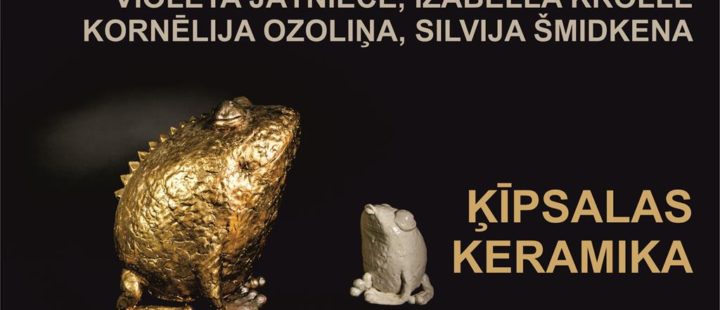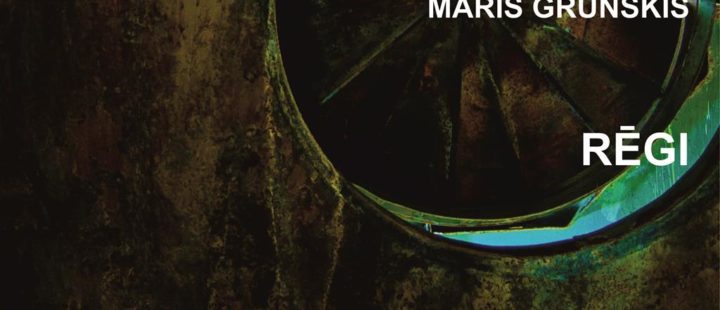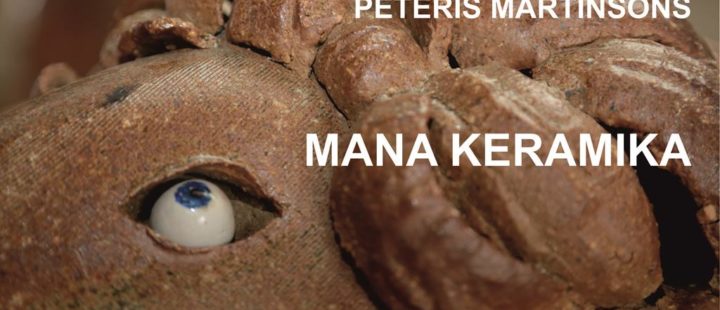Archive
Helga Kreuzritter “A GLANCE AT FIVE DECADES OF SCULPTING AND PAINTING”
- - 06.08.2015
Helga Kreuzritter
"A GLANCE AT FIVE DECADES OF SCULPTING AND PAINTING"
"I try to offer aesthetic thoughts. The fact that even some of the works are occasionally provoking is probably unavoidable and this is used by me over and over to address the viewer directly. I'm always happy when in this way I can develop conversations with my viewers, for example, at openings." Inese Āboliņa, Skaidrīte Cihovska, Violetas Jātniece, Izabella Krolle, Kornēlija Ozoliņa un Silvija Šmidkena exhibition „CERAMICS OF ĶĪPSALA”
- - 30.07.2015
Inese Āboliņa, Skaidrīte Cihovska, Violetas Jātniece, Izabella Krolle, Kornēlija Ozoliņa un Silvija Šmidkena exhibition
„CERAMICS OF ĶĪPSALA"
Ceramics of Ķīpsala – the phenomenon of Latvian art and culture of the second half of the 20th century, that has formed several generations of ceramists and has enabled strengthening of Latvian traditions in ceramics and the contemporary ceramics in Latvia in general. This was a bridge that linked the traditional and professional ceramics, taking the best from both sides, and this bridge was built by people, by artists. CYBERNETIC PAINTING OF SIGURDS VĪDZIRKSTE THE LOST CODE
- - 10.07.2015
Sigurds Vidzirkste- New York Avant-Gardist exhibition „BLACK SUN".
I am not inclined to attach great value to words. Works created from words are only a performance but not a creation. They are limited. They are only mere reflections of the direct perception. I would rather value works that grow out in the direct process of work. Painting should take place just in the physical world. The first creative idea lacks form. It is a pure essence that does not contain means of expression in itself. But then there is a second created stage of the idea with form and development which can be expressed in symbols. The idea per se is not creative, but it possesses magnetic attraction and aura which suit for a further development of new ideas. Leonid Tugalev exhibition „FotoGrāfs”
- - 03.07.2015
Leonid Tugalev exhibition „FotoGrāfs"
Leonid Tugalev
FotoGrāfs
I, Leonid Tugalev, was born in Riga, on the 8th of August, 1945. My Byelorussian grandmother was a witch. My mother was engaged in witchcraft, too. My father had a snake's wisdom, but the war made him nervous.
They are all now in the Kingdom of heaven.
I am a heathen. I believe in Nature.
I have been a workman in a sawmill, an engineer in the Institute of Design, a photographer for a magazine...
Now I have a bureau of architects. I have, as long as...
The first pictures I took were of rugby games. They were followed by portraits, or images, to be more exact. Vera - my wife - was modelling for me. Later came celebrities of Latvian arts. Reportages. Lots of exhibitions. Many awards. Maria Maier exhibition „BLOSSOM TIME”
- - 29.06.2015
Maria Maier
Blossom Time
Photographs and Paper Works
Maria Maier was born in 1954, Amberg (Germany), and has studied pedagogy and history of art. Since 1992, after a lasting period of pedagogical activity and many study and job trips while staying in South-East Asia, Central America and Africa, M. Maier is a free-lancer. She lives and works in Kofering and Regensburg. During her long experience of exhibitions she has arranged several solo exhibitions and participated in group exhibitions held in museums, art societies and galleries in Germany and abroad. Her works are seen in many collections and are exhibited in several public places. In 2005, the artist was awarded the scholarship of Virginia Center for Creative Arts in the USA, but in 2011 – the scholarship of Tyrone Guthrie Centre in Ireland. Māris Grunskis „GHOSTS”
- - 19.06.2015
Māris Grunskis „GHOSTS"
This photo series is about abandoned buildings including factories, bomb-proof shelters, communications bunkers and nuclear missile bases in Latvia. It makes the spectator to think not only about problems that are connected with maintenance of these buildings but also lets to see the unusual beauty of these places. The author tells: “In the exhibition I would like to show the attraction of desolation. These used to be places that were secret and important, places that could destroy whole cities thousands of kilometers away or – on the contrary – save peoples’ lives. Nowadays almost all of them are ghosts of political systems and conflicts from the past. The buildings are halfway torn down, looted by metal thieves, but the signs on the walls, instructions for staff and sometimes even old documentation still remain. Sometimes these ghosts are frightening, sometimes amusing, but mostly we do not even notice them on the way to our job.” After a thorough urban researching the author has come to a conclusion that these places are changing very fast, some of those that can be seen in the photographs don’t exist anymore. One of such places is the bunker of Kadaga (which used to be the command post of the Baltic Military District) “After visiting or at least seeing these places in photographs one can gain a more complete notion of the recent past. I wanted to see the elements, compositions, colors and how light acts in these very dynamic surroundings,” says the author. Pēteris Martinsons “MY CERAMICS”
- - 19.06.2015
Pēteris Martinsons "MY CERAMICS"
Pēteris Martinsons (1931 – 2013) is the best-known Latvian ceramist in the world. For more than a half of a century, his art and personality have impressed and inspired ceramists of different generations both in Latvia and abroad; his achievements in international competitions have regularly attested to the excellence of his art; the radiance coming from his personality has given a creative charge to his colleagues during workshops and symposiums, to his students, to the participants in his master workshops and to those simply encountered on his way. The personality of Pēteris Martinsons is amazingly versatile – he is an architect by education, has been professionally engaged in mountaineering, a teacher of Riga Applied Art Secondary School and Art Academy of Latvia, has been a stage designer for several theatre performances in Valmiera theatre, and has been filmed in several roles. He has traveled a lot, mainly to work there, but has always come back. Back to his own country, which he always called – the most beautiful.
In 2013, Pēteris Martinsons donated the selection of his creative life works to Daugavpils Mark Rothko Art Centre. The exhibition “Pēteris Martinsons. My Ceramics” shows large format compositions of this collection. Wyrzykowski and others – contribution of Poles to the development of photography in Latvia
- - 23.04.2015
Wyrzykowski and others - contribution of Poles to the development of photography in Latvia
Exhibition “Wyrzykowski and others - contribution of Poles to the development of photography in Latvia” consists of more than one 100 a century old photographs. The exhibition presents the works from the end of 19th and beginning of 20th century, made by Polish-origin photographers, who lived and worked at the territory of modern Latvia. All the photographs were made in 1868-1940 in Riga, Liepaja, Ventspils, Jekabpils, Daugavpils and Jelgava by Leonard Wyrzykowski, Jóżef Kowalewski, Włodzimierz Malinowski, Bolesław Talat-Kiełpsz, Leon Bećalis, Alfons Obolewicz and other photographers of Polish origin. All of them were the artists who contributed to modernization of photography at that time period, widely using new techniques, lighting and composition in their works.
The exhibition is a common project of the Embassy of the Republic of Poland in Riga and Vladimirs Eihenbaums, director of the wooden building renovation center “Koka Riga”. The photographs come from the collection of V.Eihenbaums, Jerzy Beinarowicz as well as from the private archives of the descendants of Leonard Wyrzykowski, Bolesław Talat-Kiełpsz and Leon Bećalis. Valda Mežbārde “COAST”
- - 16.04.2015
Valda Mežbārde
"COAST"
“The shore is my horizontal line, my fancy and real horizons with stones like melting islands. It is the place where I can reach infinity, tearing myself away from my reality.”
Valda Mežbārde
Valda Mežbārde, resident of Daugavpils, was born in 1946, Riga. In her childhood she read and drew much and avidly. Later she studied art in J. Rozentāls Art Secondary School and in Art Academy of Latvia. In the late 60-s and early 70-s of the 20th c. she worked as a photographer at the Latvian Art Museum where she had the opportunity to acquaint herself with the original works by Latvian artists, with work of organizing exhibitions and the world of art people in general. In 1973, the artist arrived in Daugavpils. This was the time when a lot of young artists came to live and work here. Later, many of them left the city, but Valda's work had always been linked with Daugavpils and the art life of the city. In 1974, Valda Mežbārde became a member of Latvian Artists Association, and at that time her membership contributed much to livening up the life of Daugavpils artists. She was also one of the organizers of Art Day activities in Latgale. She has participated in painting art plein-airs, has pained much and intensively, and has also tried her hand at big-size and monumental mural paintings. She has been participating in exhibitions since 1969. The artist has had more than 15 solo-exhibitions held in Latvia and abroad. Eleonora Pastare „EVENING MEDITATIONS”
- - 14.04.2015
Eleonora Pastare „EVENING MEDITATIONS"
"Colorful day and night, colorful seasons. Dreams and reality. Everything we are facing at every particular moment, especially those little things that we probably notice in a different way than others, or sometimes do not notice at all, is sufficiently important for a flight of creative thought and idea.
The variability and the constancy of nature is a never-ending source of inspiration, it is the basic foundation for creative work or for flight of dreams. And if any of these dreams is going to be materialized, there appears an insurmountable wish of sharing it with others."
Eleonora Pastare
By summing together the anniversaries of life and creative work, the year 2015 passes in a sign of "100" for the Daugavpils born artist Eleonora Pastare form Livani. Eleonara was born in 1954, in 1974 she graduated from Ceramic Department of Rezekne High School of Applied Arts and in 2007 she gained Master degree in Arts from Daugavpils University. Since 1977 Eleonora Pastare participates in exhibitions and various art projects in Latvia and abroad. She also has an extensive experience in education; more than twenty years of her creative work Eleonora "explores the world of ceramics" together with children. 









